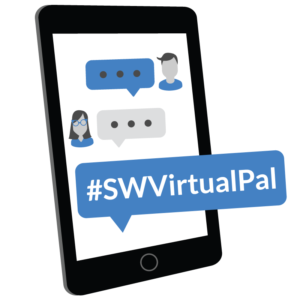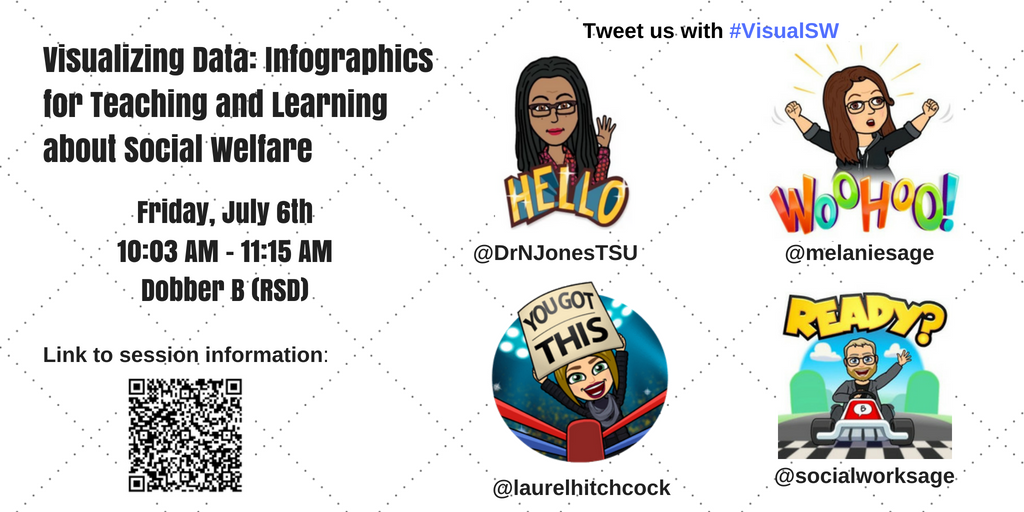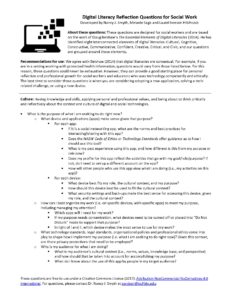BPD Technology Committee’s Technology Assessment Checklist for Social Work Practice
Editor’s Note: This blog post was written by myself and my colleague, Dr. Nathalie P. Jones. We have been the co-chairs of the BPD Technology Committee for the past two-years (2017-2019) and served as editors for the Technology Assessment Checklist described and shared in this post.
In response to the growing influence of technology in the lives of individuals and families, the Technology Committee for the Association of Baccalaureate Social Work Program Directors (BPD) has created the Technology Assessment Checklist for Social Work Practice. This tool is designed to help social workers assess clients’ relationships and comfort with technology, including strengths, needs, risks, and challenges. This blog post describes the process used by the BPD Technology Committee to create this list as well as providing a description.
History of the BPD Technology Assessment Checklist
At the 2016 Annual Conference in Dallas, TX, the BPD Technology Committee embarked on a project to help create an assessment tool for social work practitioners and educators related to digital and social technologies. The goal was for the committee members, and others who were interested in the project, to work collaboratively to develop questions that could be used with individuals and families for the purposes of assessing clients’ use and relationships with digital and social technology. After the meeting, a call was put out on the BPD Listserv and a group of ten social workers agreed to assist with creating a technology-based assessment.
#husITa18/#SWSD2018: Sustaining lifelong learning through the use of Technology-Mediated Professional Learning Networks
On Friday July 6, 2018 at 3:15 PM in the Exhibition Hall at the 2018 International Social Work, Education & Social Development Conference, Melanie Sage, Nancy J. Smyth, Jonathan Singer, and I are presenting a poster about how social workers can use technology for career-long learning, specifically by creating a Professional Learning Network (PLN).
Simply stated, PLNs employ, within an online environment, the same strategy that social work professionals have used for centuries: the practice of connecting to people who share interests and can learn from each other. PLNs are a well-established practice in the field of education (Richardson & Manacebelli, 2011). The term comes from the educational technology learning communities and has its origins in Connectivism, a learning theory developed by George Siemens (2005) to explain how network-based learning occurs in the digital age. Specifically, Connectivism suggests that learning is the process of connecting sources of information together across networks, shifting learning from an individual process to a community effort. Thus, learning includes the skills of managing the flow of information, determining what is and is not useful information, and maintaining connections with others to facilitate on-going learning (Siemens, 2005). All of these skills are developed and applied with a PLN.
We are all big fans of PLNs, and have been sharing the practice with the social work community in the US for over a year now. Nancy, Melanie and I introduced the idea of professional learning networks (PLN) to a packed room of social workers at Social Work Distance Education Conference in April 2017, and have highlighted the practice in our upcoming book with Council on Social Work Education (CSWE) Press – Teaching Social Work with Digital Technology. In October 2017, the three of us along with Jonathan shared tips and tricks for setting up a PLN at CSWE’s Annual Program Meeting. Finally, Melanie and I wrote an article for Social Work Today about PLNs was published in March.
All of us also have our own PLN that we actively employ and nurture for our own professional learning. In the following, we each describe our own PLN:
 Melanie’s PLN: My goal is to build professional relationships around my scholarships interests, and to model positive technology – use for my peers. My PLN includes:
Melanie’s PLN: My goal is to build professional relationships around my scholarships interests, and to model positive technology – use for my peers. My PLN includes:
– husITa and other technology groups: I am a board member of husITa and active with other tech groups. I follow all of them via different social media platforms and share links to technology related content.
– Facebook: I participate in several closed professional social work & technology groups on Facebook for professional reasons, but I mostly use FB to deepen my connections with colleagues and friends.
– Twitter: This is my go-to-app for initial networking as it is easy to find people, quickly learn about their interests, and engage with short posts (under 240 characters).
– Listservs: I belong to several email-based listservs where I can learn about trends and share my own research.
– CSWE Councils: I am a member of a CSWE Council and here is where I work to connect my in-person network with my digital network, by talking to others about how leaders can use social media to connect and share information.
#husITa18/#SWSD2018: A Connected Community of Learning for Practice: Social Work Virtual Pal
 On Friday July 6, 2018 at 5:39 PM in Dobber B of the RSD at the 2018 International Social Work, Education & Social Development Conference, we (Amanda Taylor and Laurel Hitchcock) will be presenting about #SWVirtualPal, an online community for social workers from around the globe with the goal of helping them to engage, learn from each other, and hopefully collaborate on international projects. The development of Social Work Virtual Pal, an innovation that builds upon the original ‘penpal’ idea, currently exists as a Twitter account @SWVirtualPal with an accompanying hashtag #SWVirtualPal. Because of our passion for digital and social technology, we designed Social Work Virtual Pal to promote and support connection through computer mediated engagement via Twitter (a microblogging social media platform), where we first met and connected. This community fills a need in global social work education and practice, that aims to link social work students, educators and practitioners from vast distances and across multiple time zones that in turn break down geographical boundaries. without having to leave their own location and using minimal resources.
On Friday July 6, 2018 at 5:39 PM in Dobber B of the RSD at the 2018 International Social Work, Education & Social Development Conference, we (Amanda Taylor and Laurel Hitchcock) will be presenting about #SWVirtualPal, an online community for social workers from around the globe with the goal of helping them to engage, learn from each other, and hopefully collaborate on international projects. The development of Social Work Virtual Pal, an innovation that builds upon the original ‘penpal’ idea, currently exists as a Twitter account @SWVirtualPal with an accompanying hashtag #SWVirtualPal. Because of our passion for digital and social technology, we designed Social Work Virtual Pal to promote and support connection through computer mediated engagement via Twitter (a microblogging social media platform), where we first met and connected. This community fills a need in global social work education and practice, that aims to link social work students, educators and practitioners from vast distances and across multiple time zones that in turn break down geographical boundaries. without having to leave their own location and using minimal resources.
In previous blog posts, we have shared our thinking around Social Work Virtual Pal, including ways that social work educators can incorporating @SWVirtualPal into the classroom. Here are links to these posts:
– #SWvirtualpal: Hashtagging for Connection
– Social Work Educator’s Guide for #SWVirtualPal
– Social Work Virtual Pal (#SWVirtualPal)… a very ‘real’ connection!
Below you’ll find our conference proposal and a link to our handout.. We’d love it if you joined us on Friday, July 7th and found your own #SWVirtualPal and shared your experiences about using online communities for learning and professional development.
Conference Handout: https://tinyurl.com/SWVirtualPalPoster
#husITa18/#SWSD2018: Visualizing Data: Infographics for Teaching and Learning about Social Welfare
 Today is the first day of 2018 Social Work, Education & Social Development Conference in Dublin, Ireland, and my first international social work conference. My first presentation will be with colleagues Nathalie Jones, Melanie Sage, and Todd Sage. We are presenting on the use of infographics in the Social Work curriculum on Friday July 6, 2018 at 10:03 AM in Dobber B of the RSD. This blog post does a few things. First, it offers an example of infographics as a tool for improving digital literacy with social work students. We also provide copies of all the presentation slides and handouts. Finally, this post helps us share and better disseminate our research findings.
Today is the first day of 2018 Social Work, Education & Social Development Conference in Dublin, Ireland, and my first international social work conference. My first presentation will be with colleagues Nathalie Jones, Melanie Sage, and Todd Sage. We are presenting on the use of infographics in the Social Work curriculum on Friday July 6, 2018 at 10:03 AM in Dobber B of the RSD. This blog post does a few things. First, it offers an example of infographics as a tool for improving digital literacy with social work students. We also provide copies of all the presentation slides and handouts. Finally, this post helps us share and better disseminate our research findings.
Three of us (Nathalie, Melanie & Laurel) have been using infographics as an assignment in our classrooms for several years and have even collected some data across our universities to ask students about the pros and cons. Guess what? The students overwhelmingly love infographic assignments. They appreciate working their creative muscles, like the opportunity to learn a new and transferable skill, and say they’ll use infographics again. Also, the technology can be a little bit frustrating, and some students are uncomfortable with the lack of structure. We argue that it’s good for students to sometimes get uncomfortable with lack of structure- this experience of managing some ambiguity is an important practice skill, as we know well!
We have shared this work in a variety of ways with our colleagues (from conferences to listservs & Twitter to water cooler conversations) in the US and are excited to bring infographics to an international conference. In a previous blog posts, we offer assignment details and even rubrics you can use to build your assignments if you are a social work educator. We share these in the spirit of service to our profession and to support your work. Here are links to these posts:
– #BPDNOLA17 – Visualizing Data: Infographic Assignments across the Social Work Curriculum: This post includes copy of the infographic assignment and links to tutorial videos.
– Teaching with Infographics: My experiences with digital literacy and non-traditional students: In this post, Nathalie provides details about how she incorporated infographics into her classroom.
Below you’ll find our conference proposal and a link to our slides. We’d love it if you joined us on Friday, July 7th and shared your comments and experiences about using infographics in the classroom.
Reflection Questions for Digital Literacy in Social Work
This post was written and edited by Nancy J. Smyth, Melanie Sage, and myself. It will be included in our forthcoming book, Teaching Social Work with Digital Technology, to be published by CSWE Press in 2018.
 Given the complexities of digital and social technology in today’s world and its effects on individuals, communities, and organizations, we argue that social work educators should teach students a holistic literacy of technology to promote, digital literacy, that is, the skills and knowledge to use information and communication technologies (ICTs) to find, critique, create, and share content (Heitin, 2016). Many websites have assessments that purport to assess one’s digital literacy. However, upon closer look, it is clear that they are often very dependent on the context of the technologies discussed such as a specific type of software, web-based application or mobile device. A good example of this in higher education is when we teach students to use a learning management system (LMS) like Canvas or Blackboard and focus only on how to upload a document within the LMS without helping them understand that the skill of uploading applies to many web-based platforms. By using digital literacy assessments with such a narrow focus, it means they become obsolete quickly and are not relevant to all contexts such as how features of an app may look different on a smartphone compared to a laptop.
Given the complexities of digital and social technology in today’s world and its effects on individuals, communities, and organizations, we argue that social work educators should teach students a holistic literacy of technology to promote, digital literacy, that is, the skills and knowledge to use information and communication technologies (ICTs) to find, critique, create, and share content (Heitin, 2016). Many websites have assessments that purport to assess one’s digital literacy. However, upon closer look, it is clear that they are often very dependent on the context of the technologies discussed such as a specific type of software, web-based application or mobile device. A good example of this in higher education is when we teach students to use a learning management system (LMS) like Canvas or Blackboard and focus only on how to upload a document within the LMS without helping them understand that the skill of uploading applies to many web-based platforms. By using digital literacy assessments with such a narrow focus, it means they become obsolete quickly and are not relevant to all contexts such as how features of an app may look different on a smartphone compared to a laptop.
To help social work educators and practitioners understand their own digital literacies more deeply as well as help others such as students or workshop participants, we are presenting some questions that serve as a starting point for reflection as you consider teaching with technology, as well as helping students enhance their digital literacies. These questions are grounded in the work of Doug Belshaw and his book The Essential Elements of Digital Literacies. He has identified eight interconnected elements of digital literacies: Cultural, Cognitive, Constructive, Communicative, Confident, Creative, Critical, and Civic, and our questions are grouped around these elements. Here are some brief definitions of each element with some sample reflection questions for each element (a handout with all the questions is available later in this post):
Review of Teaching & Learning in Social Work for 2017
 One of my favorite things to do at the end of the year is to read all of the “year-in-review” lists. Books, records, movies, top ten social work journal articles – it doesn’t matter what the list is about, I’ll read it. I am always curious how and why people choose to rank their favorite things from the year. This must be because I find it hard to choose a favorite book or movie when there are so many good options, and how can I exclude anything as a social worker, the profession that loves diversity and strives for inclusion. So for 2017, I offer a list for the Teaching & Learning in Social Work Blog. Not the top-ten blog posts, but the entire year. Here are the numbers:
One of my favorite things to do at the end of the year is to read all of the “year-in-review” lists. Books, records, movies, top ten social work journal articles – it doesn’t matter what the list is about, I’ll read it. I am always curious how and why people choose to rank their favorite things from the year. This must be because I find it hard to choose a favorite book or movie when there are so many good options, and how can I exclude anything as a social worker, the profession that loves diversity and strives for inclusion. So for 2017, I offer a list for the Teaching & Learning in Social Work Blog. Not the top-ten blog posts, but the entire year. Here are the numbers:
Number of Blog Posts in 2017 – My goals was to write or publish at least two posts a month, which happened more months than not:
Total Blog Posts = 25
Highest number of Blog Posts published in one month = 6 (October)
Lowest number of Blog Posts published in one month = 0 (August)
Guest Educator Posts in 2017 – Another goal I have for this blog is to provide a space for others to share their work, particularly work that does not fit into the traditional academic publication venues. For 2017, I am thrilled that eight social work educators wrote seven different blog posts about their scholarship of teaching and learning for the blog. I want to thank all of these authors for sharing their work and for all they do to educate future social workers!
Scholarship Dissemination Posts – My final goal for the year was to write more about my own scholarship by sharing content from conference presentations and any published articles. I published seven posts about national conference presentations with colleagues, and wrote about one article I had published in 2017. Clearly, I am doing more conferencing than publishing.
Below is a list of this year’s post grouped around the topics of assignments, projects, guest educator posts, and conference presentations.


